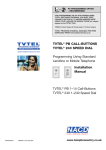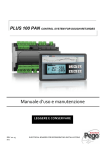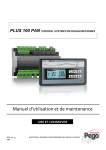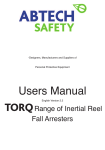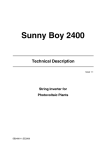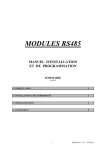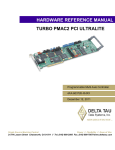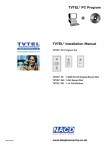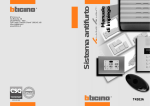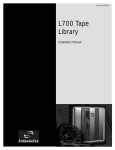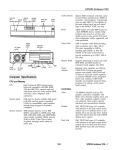Download Pelco Door ECP290 User's Manual
Transcript
ECP190 / ECP290 DOOR CONTROLLERS STAND ALONE ACCESS CONTROL Site Coded & Sequentially Numbered Access Passes for Security, Identification & Operational Integrity. ® nacd.co.uk contents ECP190 ECP190 / ECP290 / ECP290 DOOR DOORCONTROLLERS CONTROLLERS Explanation of Noralsy ® Access Passes 3 General Door Controller Information 4 ECP 190 Door Controller schematic 5 ECP 290 Door Controller schematic 6 How to use the Telpro™ programmer 7-8 Programming Set-up on installation 9-10 Block loading of Access Passes 10 Deleting individual Access Passes 10-11 Validating individual Access Passes 11 Block deletion of Access Passes 11 Changing lock output time 11 Changing the Master Code 11 ECP290 Additional Features 12-13 Dual Security, Code + Access Pass 13 Fail Safe locking schematic 14 Automation/Volt Free schematic 14 General Locking schematic 15 Din Rail Mounting 15 Din Rail Power Supplies 16 Powering ECP Door Controllers using Din Rail PSU 17 Programming Keypad Codes 18-19 2 NORALSY® ACCESS PASSES ALL ACCESS PASSES ARE VISIBLY NUMBERED Numbered The number of each and every Access Pass is visible. Just by looking at it, you know which Access Pass you have. Noralsy® pre-number each Access Pass because this is the only way you can know for sure what you have received, what you need to program the system to accept (or, reject in the case of loss, theft or non-return) and, who has been issued with which TELBIP Access Pass. or TELBIPHF KCP3 Proximity Key Numbered ALL ACCESS PASSES ARE SITE CODED An Access Pass is always part of a unique group referred to as a Site Code and represented by a 5 digit number. Your purchase of Noralsy® Access Passes buys you Rear of that group (Site Code) regardless of how many Access Passes you require. That Site TELBIP/TELBIPHF Code belongs to you and you alone. Noralsy® will never make an Access Pass with or TELBIPHFP your Site Code for anybody else. That is your security. Site Code The first 3no. digits of the 5no. digit Site Code are always engraved on each Access Pass. The last 2no. digits are usually the year of manufacture. KCP3 Proximity Key Example: First 3 digits engraved on Access Pass are 494. Year of manufacture 2001, therefore, last 2n0 digits of site code are 01. Site Code = Engraved on Access Pass Not engraved* Site Code The full 5no. digit Site Code is written on the Access Pass Information Sheet supplied by Noralsy® with each delivery of Access Passes. *The full 5n0 digit site code is printed on KBP Proximity Cards. ALL ACCESS PASSES ARE SEQUENTIALLY NUMBERED Rear of TELBIP/TELBIPHF or TELBIPHFP Holder Number Access Passes are always supplied in groups that are sequentially numbered which simplifies programming because it enables block loading and block deleting of Access Passes. It also means that you can quickly and easily determine which Access Passes are missing and need, therefore, to be deleted in order to restore the integrity of your system. KCP3 Proximity Key Last 3 digits engraved refer to Holder Number. The Holder Numbers supplied are also recorded on the Access Pass Information Sheet. 3 Holder Number Noralsy ECP Door Controllers ® IMPORTANT –If NOT Monitoring Door Open/Closed Status OR ECP ALARM BUZZES CONTINUOUSLY ELEC/INST/800 6 5 4 3 2 1 ON 6 5 4 3 2 1 1 ECP Door Controller Standardisation of Terminal Numbering Place Noralsy unit on a flat surface with PCB facing skywards. View terminal blocks from the outside looking in. Terminal No. 1 is always the first on the left of every terminal block strip. 1 2 3 1 2 3 4 1 2 1 2 3 1 2 3 1 2 1 2 3 4 5 1 2 3 4 5 6 1 2 3 4 1 2 3 1 2 3 1 2 3 4 5 6 1 2 3 1 2 3 4 5 6 7 8 1 2 3 4 5 1 2 3 4 5 6 7 ELEC/INST/GEN 4 1 2 3 4 5 6 ECP190 Door Controller for 1 n0 Door/Access Point ■ Capacity 999 Users ® ELEC/INST/801 ECP 190 Door Controller 3 2 1 3 2 1 2 1 (—) (+) Supply 12V DC ± 10% Dimensions 103 L x 106 W x 83 D (6 DIN units) Weight 0.44 Kg Power Consumption 55mA quiescent CE Norms EN50082, EN55022 Class B 3 2 1 2 1 1 5 2 4 3 3 4 2 5 1 1 1 2 3 4 5 6 ON 1 2 3 4 5 6 = = 1 2 3 4 5 6 If not used, link terminals 3 & 4 to create a permanently closed circuit. 5 ECP290 Door Controller for 2n0 Doors/Access Points ■ Capacity 999 Users per door ® ELEC/INST/830 ANTI-PASSBACK FEATURE AVAILABLE ECP 290 Door Controller * If not used, link terminals 3 & 4 to create a permanently closed circuit. 6 Supply 12V DC ± 10% Dimensions 163 L x 106 W x 83 D (10 DIN units) Weight 0.56 Kg Power Consumption 160mA quiescent CE Norms EN50082, EN55022 Class B Programming Stand-Alone Access Control Systems using TELPRO™ Programmer. ® TELPRO™ PROGRAMMER Access Control Modules with integral Infra-Red The TELPRO™ Programmer is a handheld keypad used for programming Noralsy® stand-alone access control systems. MLP3 Proximity The TELPRO™ Programmer can be used as a wirefree infra-red programmer. Simply point at the reader/receiver module to program. Installation companies only ever need 1no. TELPRO™ Programmer. TELPRO™ can be used on any system provided, of course, the Master Code (also referred to as the Engineer Code) which grants access into programming mode is known or, access to the ECP Door Controller itself is available. The final customer only needs a TELPRO™ unit if they wish to effect programming themselves. MIR Infra-Red TELPRO™ Programmer Access Control Modules, Readers, Receivers without integral Infra-Red The TELPRO™ Programmer is supplied with a connector cable. Simply connect to ECP Door Controller to program. LB20 Swipe Card LTP03 Office Proximity Reader TELPRO™ Programmer ECP190 ECP290 ECP100 ECP200 MILB Card Reader LHF Dim: 120L x 60W x 25D Radio receiver If the entrance or door panel includes a MICAM/MICIM Keypad Module connected to the ECP Door Controller, all programming can be effected directly via the MICAM/MICIM Keypad ie. TELPRO™ Programmer would not be required. You would also then have the option of having keypad access codes. All measurements in millimetres. 7 Programming using TELPRO™ as a remote wire-free programmer. Remote Programming Range: Infra-Red Receiver Proximity Reader 20 cms - 5 metres 5 cms - 10 cms How to use the TELPRO: Important: Each press of a button is confirmed (as received) by the reader/receiver by a single beep. Press the TELPRO™ buttons gently. Flick TELPRO switch to ON - Red LED on the right must light up. (Remember to turn unit off when finished) Dimensions (mm): 120L x 60W x 25D Point TELPRO at the reader/receiver. Enter the Master Code and wait for the reader/receiver to start beeping every 4 seconds OR Flick Programming Switch SW1 and wait for the reader/receiver to start beeping every 4 seconds (Remember to turn off the programming switch SW1 when you have finished programming). Follow programming instructions Note: An incorrect programming operation is signalled by a series of 3 beeps. Programming using TELPRO™ as a hard-wired programmer ECP290/ECP200 J5 J6 How to use the TELPRO as a hard wired unit: = Access Point 1 = Access Point 2 Insert the jack connection into the top of the TELPRO unit. Plug the connector terminal onto J5 on ECP Door Controller. Enter the Master Code and wait for the unit to start beeping every 4 seconds OR Flick Programming Switch SW1 and wait for the unit to start beeping every 4 seconds (Remember to turn off the programming switch SW1 when you have finished programming) Follow programming instructions. 8 Important: Each press of a button is confirmed (as received) by the Door Controller by a single beep. Press the TELPRO™ buttons gently. ECP Door Controller with ACCESS PASS CONTROL PROGRAMMING TOP POINTS TO REMEMBER ■ Programming is effected via the TELPRO programming keypad. ■ ■ Site Code is always a 5 digit number. Site Code is always stored in Slot No. 01. ■ ■ Master Code (Programming Access Code) is always a 5 digit number. Master Code is always stored in Slot No. 06. TIP - WHEN YOU ARE PROGRAMMING It is a good idea to have written down in advance what you want to program. Enter the numbers in quick succession after a beep. Do not wait more than 2-3 seconds in between entering numbers as this will confuse the system. SET-UP ON INSTALLATION Wire up according to appropriate electrical wiring schematic for your installation, then power up the Door Controller. Flick the Programming Switch SW1. The unit will start beeping every 4 seconds. STEP 1 Decide Now -- For how many seconds do you want the door to open: Example 08 After a beep enter on the TELPRO: 000005 08 seconds Basic configuration, just do it! The last 2no. digits, shown as underlined, set the door open time in seconds. You can choose any length between 01 99 seconds. For automation control, 01 seconds is usually more than adequate. A sharp beep confirms that you have correctly entered the above. Programming mode beep - every 4 seconds resumes. STEP 2 After a beep enter on the TELPRO: Basic configuration, just do it! 02A0 A sharp beep confirms that you have correctly entered the above. Programming mode beep - every 4 seconds resumes. STEP 3 You must now set the Master Code of your choice. This is the code that allows you to access programming mode without having to open up the Door Controller and flicking switch SW1. The Master Code is always stored in Slot No. 06. The Master Code must be a 5 digit number, for example: 19388. After a beep enter on the TELPRO: A sharp beep confirms that you have correctly entered the Master Code. Programming mode beep - every 4 seconds resumes. 9 STEP 4 You must now inform the Door Controller of the Site Code of the Access Passes supplied. The Site Code is always stored in Slot No. 01. The Site Code is always a 5 digit number. Check the Access Pass Information Sheet delivered with the Access Passes. It will tell you the Site Code of the Access Passes delivered. * Example: Site Code = 45801 After a beep enter on the TELPRO: A sharp beep confirms that you have correctly entered the Site Code. Programming mode beep - every 4 seconds resumes. *KBP Proximity Cards have the full site code printed on each card. STEP 5 You must now inform the Door Controller of the Access Pass Holder Numbers supplied. Check the Access Pass Information Sheet delivered with the Access Passes. It will tell you which Holder Numbers we have supplied. Example: 150no. Access Passes Supplied........HOLDER NUMBERS 001-150. *See Tip Wizard on page 13 After a beep enter on the TELPRO: A series of 3no. beeps followed by a sharper beep confirms that you have correctly entered the Holder Numbers. Programming mode beep - every 4 seconds - resumes. STEP 6 Turn off programming switch SW1 in the Door Controller. You have successfully programmed the system. The Access Passes should now all work. ADVANCED PROGRAMMING In the following examples of programming we are assuming that the Master Code = 19388. This is purely for demonstration purposes. When programming for real, you must enter the Master Code that you chose and set when the system was installed. Example A: Block Loading/Validation of Access Passes. You have just received an additional 25no. Access Passes for the system. Holder Numbers 151- 175. Enter the Master Code 19388 on the TELPRO. Beeps every 4 seconds indicate that you have accessed Programming Mode. After a beep enter on the TELPRO: A series of 3no. beeps followed by a sharper beep confirms that you have correctly entered the Holder Numbers. Programming mode beep - every 4 seconds - resumes. Example B: Deletion of 1no. Access Pass You have just been informed that Alan Jones has lost his Access Pass. Alan was Holder Number 074. You have to delete it immediately to restore system security. Enter the Master Code 19388 on the TELPRO. Beeps every 4 seconds indicate that you have accessed Programming Mode. 10 After a beep enter on the TELPRO: A sharp beep confirms that you have correctly deleted Holder Number 074. Programming mode beep - every 4 seconds - resumes. Example C: Validation of 1no. Access Pass You have just received the additional Access Pass ordered for Alan Jones who had lost his earlier in the week. The last 3no. digits on the Access Pass are 176. Alan Jones is now Holder Number 176 and you have to program the system to accept Holder Number 176. Enter the Master Code 19388 on the TELPRO. Beeps every 4 seconds indicate that you have accessed Programming Mode. After a beep enter on the TELPRO: A sharp beep confirms that you have correctly programmed new Holder Number 176. Programming mode beep - every 4 seconds - resumes. Example D: Block Deletion of Access Passes You have just been informed that a set of 20 Access Passes reserved for visitors and held in reception have been stolen. You have to immediately delete them to restore system security. The Holder Numbers stolen were 080-099. Enter the Master Code 19388 on the TELPRO. Beeps every 4 seconds indicate that you have accessed Programming Mode. After a beep enter on the TELPRO: A series of 3no. beeps followed by a sharper beep confirms that you have deleted the Holder Numbers. Programming mode beep - every 4 seconds - resumes. Example E: Changing the Relay/Lock Output Time You have been asked to change the Relay Output Time to 12 seconds. Enter the current Master Code 19388 on the TELPRO. Beeps every 4 seconds indicate that you have accessed Programming Mode. After a beep enter on the TELPRO: A sharp beep confirms that you have correctly reprogrammed the relay output time for 12 seconds. Programming mode beep - every 4 seconds - resumes. Example F: Changing the Master Code You have been asked to change the Master Code to 11821. Enter the current Master Code 19388 on the TELPRO. Beeps every 4 seconds indicate that you have accessed Programming Mode. After a beep enter on the TELPRO: A sharp beep confirms that you have correctly entered the new Master Code. Programming mode beep - every 4 seconds - resumes. 11 ECP290 DOOR CONTROLLER INFORMATION FOR 2 DOORS – IMPORTANT FLICKING PROGRAMMING SWITCH SW1. The access control readers on both doors will start to beep every 4 seconds indicating programming mode status. Only 1 no. access point (door) can be programmed at a time. IF USING THE TELPRO PROGRAMMER IN WIREFREE INFRA-RED MODE: Simply point at the relevant reader to effect programming for its related access point (door). Repeat the process for the 2nd access control reader on the ECP290. Remember to turn off programming switch SW1 when finished. IF USING TELPRO PROGRAMMER IN HARDWIRED MODE: Connect as follows: J5 for the reader connected to I2A1, Access Point 1. J6 for the reader connected to I2A2, Access Point 2. Remember to turn off programming switch SW1 when finished. Note: Programming mode can, of course, be accessed via entering the Master Code (the code stored in Slot No. 06) as explained earlier. ADDITIONAL FEATURES OF ECP290 Activating one of the additional features offered by the ECP290 is very straightforward and involves a very slight modification of Step 1 (see page 9) of the Programming Operation. Remember: The programming operation has to be effected for each access point (door). 00000508 = Standard Set-Up, adequate for the vast majority of installations. If this is sufficient, simply copy the procedure, as explained on page 9, for both doors. Mode 2 - Access Pass to Operate Only if Vehicle Present 00200500 = Set-Up, Mode 2 È Alarm delay time in minutes. A 00 setting disables the alarm function. When a valid access pass is presented to the reader, the relay output will be activated for 2 seconds BUT ONLY IF the Magnetic Induction Loop (M.I.L) contacts, terminals 1 & 2 of J10A1 or J10A2, have closed ie a vehicle is present. If the M.I.L contacts remain closed for longer than the preset alarm delay time, the access control reader/receiver/keypad will sound an alarm. Mode 3 - Access Pass to Operate Only if Door Closed 00300500 = Set-Up, Mode 3 È Alarm delay time in minutes. A 00 setting disables the alarm function. The status of the door is controlled by 2no. sets of contacts as follows: Open Position Reached (OPR) Contacts: Door Open Contacts (DO): Terminals 2 & 3 of J10A1 (Access Point 1) Terminals 3 & 4 of J9A1 (Access Point 1) Open Position Reached (OPR) Contacts: Door Open Contacts (DO): Terminals 2 & 3 of J10A2 (Access Point 2) Terminals 3 & 4 of J9A2 (Access Point 2) When a valid access pass is presented to the reader, the relay output will be activated for 2 seconds BUT ONLY IF the related Access Point (Door) is closed. If the Access Point (Door) remains open for longer than the preset alarm delay time (DO Contacts OPEN and OPR Contacts CLOSED) or, if the Access Point (Door) is blocked/stuck for longer than the preset alarm delay time (DO Contacts OPEN and OPR Contacts OPEN), the access control reader/receiver/keypad will sound an alarm. 12 Mode 4 - Dual Security, Access Pass + Keypad Code 00400508 = Set-Up, Mode 4 È Relay output time in seconds User required to present a valid access pass and then enter a valid code or vice versa in order to gain access. A maximum of 27no. 5 digit keypad codes can be set at any one time. Any 1no. of these keypad codes together with a valid access pass is sufficient to gain entry. This feature is also available on the ECP190 Door Controller. Mode 5 - Anti-Passback 00500508 = Set-Up, Mode 5 È Relay output time in seconds (this is an example only). For Anti-Passback to operate, terminals 3 and 4 of J9A1 and J9A2 must be connected to the Door Contacts fitted to the controlled doors. This is imperative because the Door Controller cannot operate Anti-Passback if it does not know whether the door was opened or not. Basic operation is as follows: The presentation of a valid Access Pass on Door 1 activates the relevant lock release relay. If Door 1 is opened, this Access Pass is immediately and automatically barred on Door 1 until it has been presented on Door 2 with Door 2 then being opened. As soon as this Access Pass is presented on Door 2 with Door 2 being opened, it is immediately and automatically barred on Door 2 until it has been presented on Door 1 with Door 1 then being opened etc etc. Tip Wizard Access Passes can be programmed into the access control system even if they have not yet been manufactured by Noralsy® . Your customer may have ordered only 50no. Access Passes and would have had delivered, for example holders 001-050 on their unique Site Code but, there is nothing to stop you from block programming all 999 holders. It takes the same amount of time to program 1no. Access Pass into the system as it does to program 999 Access Passes! So, future supplies of Access Passes are already programmed into the system and your customer should only ever have to delete lost or stolen Access Passes! It is so easy: B001 B999. VERY IMPORTANT Noralsy® Access Passes must not be compared or confused with random Access Passesfor example, certain brands of proximity key - where the onus is on the installation company to “accurately” identify each Access Pass programmed into the system and physically mark them so that they can be “sure” who is issued with what or, those systems, which rely on shadow cards or master keys/fobs for programming purposes. 13 Noralsy® ECP Door Controller ® Fail Safe Locking + 3 2 1 3 2 1 2 1 (—) (+) ELEC/INST/802 ECP190 Door Controller Automation Control / Volt Free 3 2 1 3 2 1 2 1 ELEC/INST/803 ECP190 Door Controller Entrance/Exit Access point requiring access control on both sides of the door, gate or barrier. ie. Access Pass to be presented to enter and again to exit through the same control point. 1 2 3 4 5 6 6 5 4 3 2 1 6 5 4 3 2 1 6 5 4 3 2 1 Note: In this type of installation, programming can take place via the TELPRO programmer at either one of the Access Pass readers/receivers or, alternatively, at the Door Controller itself. You only need to program at 1no. point. * Terminal numbering shown for reasons of schematic clarity. Terminal 1 is actually first on left. ECP190 Door Controller ELEC/INST/804 14 Noralsy® ECP Door Controller ® Locking 3 2 1 3 2 1 ECP190 Door Controller 2 1 (–) (+) ELEC/INST/805 DIN Rail Mounting DIN Rail ELEC/INST/806 Wall Mounting ELEC/INST/807 15 Noralsy® DIN Rail Power Supplies ® ARE121 12V AC/DC 1 AMP MAXIMUM OUTPUT ARE122 12V DC 2 AMP MAXIMUM OUTPUT ELEC/INST/808 ELEC/INST/809 ARS122 12V DC 2 AMP MAXIMUM OUTPUT AB126 BATTERY STANDBY ELEC/INST/811 ELEC/INST/810 16 Noralsy® Powering ECP Door Controller(s) using Noralsy® DIN Rail Power Supply Units ® ARE121 + ECP190 ELEC/INST/812 ARE122 + ECP290 ELEC/INST/812A 17 ECP190 DOOR CONTROLLER with KEYPAD ACCESS CODE CONTROL TOP POINTS TO REMEMBER ■ Programming is effected directly via the keypad. ■ ■ Master Code (Programming Access Code) is always a 5 digit number. Master Code is always stored in Slot No. 06. ■ ■ Keypad Access Codes are always 5 digit numbers. Keypad Access Codes can be stored in Slot Nos. 03 - 05 and 07 - 30 only. SET-UP ON INSTALLATION Proceed exactly as detailed before in section ECP Door Controller with Access Pass Control. Stop when you have completed Step 3. Then - Turn off programming switch SW1 in the Door Controller. PROGRAMMING KEYPAD ACCESS CODES Keypad Access Codes must be 5 digits in length and can only be stored in Slot Numbers 03-05 and 07-30. Example: You want to program codes: 46296 for Alan 78327 for Tony 32534 for Alex Enter the Master Code on the keypad: Beeps every 4 seconds indicate that you have accessed Programming Mode. After a beep enter on the keypad: A sharp beep confirms that Alan’s code is recorded. Programming mode beep - every 4 seconds - resumes. After a beep enter on the keypad: A sharp beep confirms that Tony’s code is recorded. Programming mode beep - every 4 seconds - resumes. After a beep enter on the keypad: A sharp beep confirms that Alex’s code is recorded. Programming mode beep - every 4 seconds - resumes. Note Carefully: Never program a keypad access code into Slot Numbers 01, 02 or 06. DELETING KEYPAD ACCESS CODES Example: You want to delete Alan’s code 46296 which is stored in Slot No. 03 You want to delete Alex’s code 32534 which is stored in Slot No. 07 Enter the Master Code on the keypad: Beeps every 4 seconds indicate that you have accessed Programming Mode. 18 After a beep enter on the keypad: A sharp beep confirms that you have deleted Alan’s code. Programming mode beep - every 4 seconds - resumes. After a beep enter on the keypad: A sharp beep confirms that you have deleted Alex’s code. Programming mode beep - every 4 seconds - resumes. Note 1. You do not need to know the actual code itself which needs to be deleted, only the Slot Number in which it is stored. Note 2. Capacity is never reduced as a result of deleting codes. You can always add or change codes. CHANGING THE MASTER CODE Refer to page 11. CHANGING RELAY/LOCK OUTPUT TIME Refer to page 11. Automatic Time-Out – whenever programming accessed via Master Code System automatically reverts to normal mode approximately 20 seconds after the last programming operation. A single longer sharp beep signals that the system has exited from programming mode and returned to normal mode. 19 ARE122 POWER SUPPLY ECP 190 DOOR CONTROLLER Supply 12V DC ±10% Dimensions 103 L x 106 W x 83 D (6 DIN units) Input 85VAC - 264VAC Output 12V DC - 2AMP Dimensions 160 L x 106 W x 85 D (10 DIN units) Weight 0.44 Kg Power Consumption 55mA quiescent CE Norms EN50082, EN55022 Class B Weight 0.5 Kg CE Norms EN55022 Class B, EN 60950, UL 94 VO ARS122 POWER SUPPLY WITH STAND-BY FACILITY ECP 290 DOOR CONTROLLER Input 85VAC - 264VAC Output 12V DC - 2AMP Supply 12V DC ± 10% Dimensions 160 L x 106 W x 85 D (10 DIN units) Dimensions 163 L x 106 W x 83 D (10 DIN units) Weight 0.5 Kg Weight 0.56 Kg CE Norms EN55022 Class B, EN 60950, UL 94 VO Power Consumption 160mA quiescent CE Norms EN50082, EN55022 Class B AB126 BATTERY STANDBY Battery 12V/6A.H. ARE121 POWER SUPPLY WITH STAND-BY FACILITY Output 12V DC - 2AMP Input 85VAC - 264VAC Dimensions 162 L x 106 W x 112 D (10 DIN units) Output 12V AC/DC - 1AMP Weight 3.0 Kg CE Norms VDS, IEC 1056 Dimensions 135 L x 106 W x 85 D (8 DIN units) Weight 1.05 Kg CE Norms EN50082, EN55022 Class B ACCESS CONTROL MODULES REFERENCE DESCRIPTION POWER CONSUMPTION MIR Infra-Red Receiver 25mA quiescent MILB Card Reader Insert 47mA quiescent LB20 Card Reader Swipe 30mA quiescent MICAM/MICIM Keypad 50mA quiescent MLP3 Proximity Reader 120mA quiescent LHF Radio Receiver 25mA quiescent LPT03 Proximity Reader (office) 120mA quiescent N.A.C.D. Limited Unit 10, Avebury Court, Mark Road, Hemel Hempstead, Herts HP2 7TA. TEL: 01442 211848 FAX: 01442 212776 EMAIL: [email protected] WEB: www.nacd.co.uk Our policy is one of continuous product improvement, we reserve the right to change specifications and prices without notice. All information is given in good faith. No responsibility can be accepted for errors, omissions or incorrect assumptions. Picture reproduction of products are within the limitations of both colour and black and white printing and are intended as a guide only. © Copyright 2001 N.A.C.D. Limited. All rights reserved. 20




















